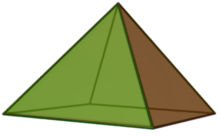Square pyramidal molecular gemometry
| Square pyramid | |
|---|---|
 |
|
| Type |
Johnson J92 – J1 – J2 |
| Faces | 4 triangles 1 square |
| Edges | 8 |
| Vertices | 5 |
| Vertex configuration | 4(32.4) (34) |
| Schläfli symbol | ( ) ∨ {4} |
| Symmetry group | C4v, [4], (*44) |
| Rotation group | C4, [4]+, (44) |
| Dual polyhedron | self |
| Properties | convex |
| Net | |
 |
|
In geometry, a square pyramid is a pyramid having a square base. If the apex is perpendicularly above the center of the square, it will have C4v symmetry.
If the sides are all equilateral triangles, the pyramid is one of the Johnson solids (J1). The 92 Johnson solids were named and described by Norman Johnson in 1966.
A Johnson solid is one of 92 strictly convex polyhedra that have regular faces but are not uniform (that is, they are not Platonic solids, Archimedean solids, prisms or antiprisms). They were named by Norman Johnson, who first listed these polyhedra in 1966.
The Johnson square pyramid can be characterized by a single edge-length parameter a. The height H (from the midpoint of the square to the apex), the surface area A (including all five faces), and the volume V of such a pyramid are:
Other square pyramids have isosceles triangle sides.
For square pyramids in general, with base length l and height h, the surface area and volume are:
Square pyramids fill space with tetrahedra, truncated cubes or cuboctahedra.
The square pyramid is topologically a self-dual polyhedron. The dual edge lengths are different due to the polar reciprocation.
...
Wikipedia
